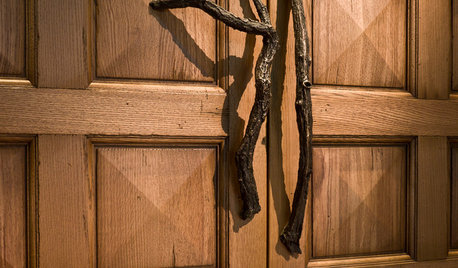Diminishing oak grain on staircase hand rail
bigdoglover
13 years ago
Related Stories

WOODWoodipedia: Make a Solid Choice With Oak
Forget those low-end products of old. Red and white oak today are beautiful, versatile and relatively inexpensive
Full Story
KITCHEN OF THE WEEKKitchen of the Week: Goodbye, Honey Oak — Hello, Minty Green
After more than 30 years, the Kloesels revamped their space to reflect their rural country town and Victorian-style home
Full Story
MATERIALSRaw Appeal: 9 Wonderful Ways With Natural Wood
Go with the grain and use minimally finished wood for gorgeous accent walls, artwork and more
Full Story
DECORATING GUIDESNovel Ways With Bedroom Books
Reading and relaxing go hand in hand. See how designers are incorporating mini and all-out libraries in the bedroom
Full Story
BEFORE AND AFTERSMy Houzz: A 1950s Bungalow Grows Up and Greens Out
Beauty and energy efficiency go hand in hand in this expanded and renovated Massachusetts forest home
Full Story
How to Update a Traditional Staircase
Paint and Contrast Give Your Stairwell Some Contemporary Dash
Full Story
STAIRWAYS17 Ideas for Storage Under the Stairs
It’s not just about the ups and downs. These clever staircases also provide storage, display and seating
Full Story
HOUZZ TOURSHouzz Tour: Wild for Wood in Central Texas
Mesquite, cherry and white oak harmonize beautifully in an Austin family's warm and modern home
Full Story










bobismyuncle
bobismyuncle
Related Professionals
Land O Lakes Cabinets & Cabinetry · Fairfax Carpenters · Enterprise Carpenters · Fair Oaks Carpenters · Lake Worth Carpenters · Needham Carpenters · Avon Flooring Contractors · Cranston Flooring Contractors · Hialeah Gardens Flooring Contractors · Norfolk Flooring Contractors · Norton Flooring Contractors · Hastings Furniture & Accessories · Aliso Viejo Furniture & Accessories · Clark Furniture & Accessories · Fairfax HandymanbigdogloverOriginal Author
brickeyee
bigdogloverOriginal Author
bobismyuncle